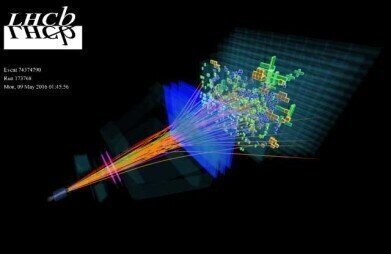News & Views
Detectors Uncover Hidden Baryons
Mar 26 2017
A team of scientists working on the Large Hadron Collider beauty experiment has announced an exceptional and unique observation of five new baryons, particles composed of three quarks. Quarks are one of the fundamental building blocks for matter, combining to make hadrons.
Tara Shears, Professor of Physics at University of Liverpool and Liverpool’s LHCb group lead, explains why this discovery is significant: "These particles have been hiding in plain sight for years, but it's taken the exquisite sensitivity of LHCb's particle detectors to bring them to our attention.”
The LHCb) experiment is one of seven experiments collecting data at the Large Hadron Collider at CERN and is investigating the subtle differences between matter and antimatter in a bid to answer one of the most fundamental questions – why is our Universe made of matter? UK participation is funded by STFC, with contributions from the participating institutes, the Royal Society and European Union.
These new baryons are high-energy excited states of the Omega c baryon, which were discovered when the scientists reconstructed the short-lived Omega-c baryon from its decay to a Xi baryon and subsequent decay into a proton, a kaon K-, and a pion. By studying the trajectories and energies deposited by all the particles, LHCb scientists uncovered the five distinct new excited Omega_c baryon states.
Professor Shears explained how the UK’s future involvement will be vital: “We need the precision trajectory information from the VELO detector to reconstruct the trail of particles these new baryons produce and information from the RICH detectors to know what these particles are - both detectors that the UK helped build. If we're uncovering these new particles now, who knows what else is in our data waiting to be discovered?"
Using the vast amounts of data collected during the operational life of the Large Hadron Collider and the fantastic precision of LHCb’s detectors, scientists have been able to confirm the discovery is not just a fluke.
Physicists will now determine the precise properties of these new particles, which will contribute to our understanding of how quarks are bound inside a baryon.
Digital Edition
Lab Asia 31.2 April 2024
April 2024
In This Edition Chromatography Articles - Approaches to troubleshooting an SPE method for the analysis of oligonucleotides (pt i) - High-precision liquid flow processes demand full fluidic c...
View all digital editions
Events
Apr 28 2024 Montreal, Quebec, Canada
May 05 2024 Seville, Spain
InformEx Zone at CPhl North America
May 07 2024 Pennsylvania, PA, USA
May 14 2024 Oklahoma City, OK, USA
May 15 2024 Birmingham, UK


















